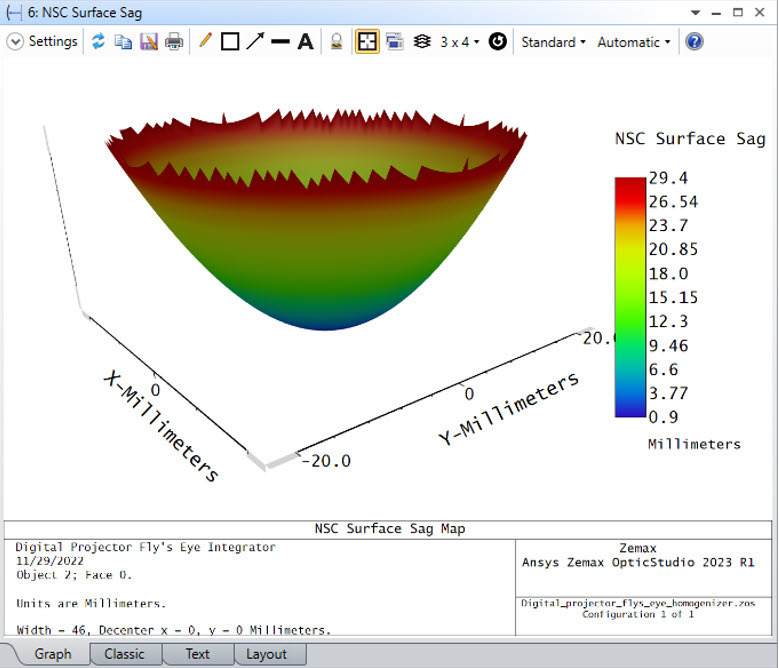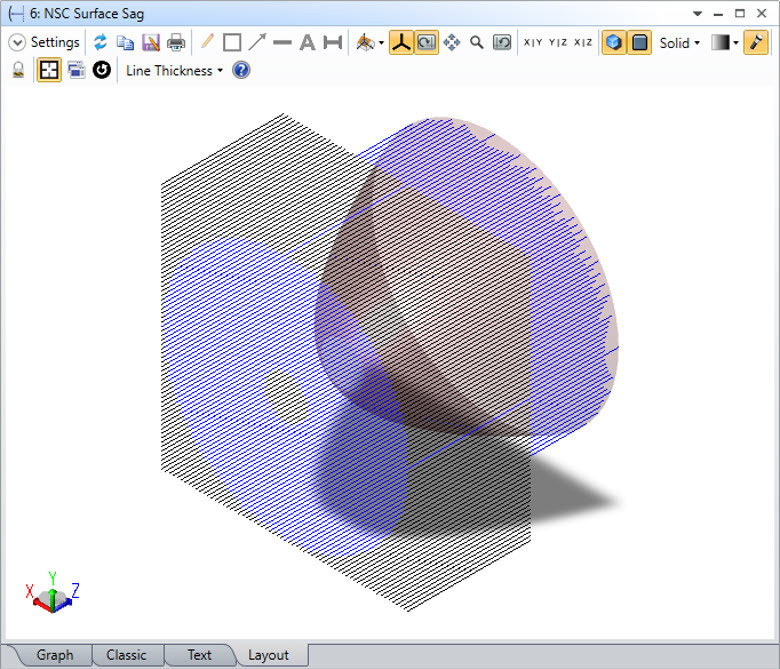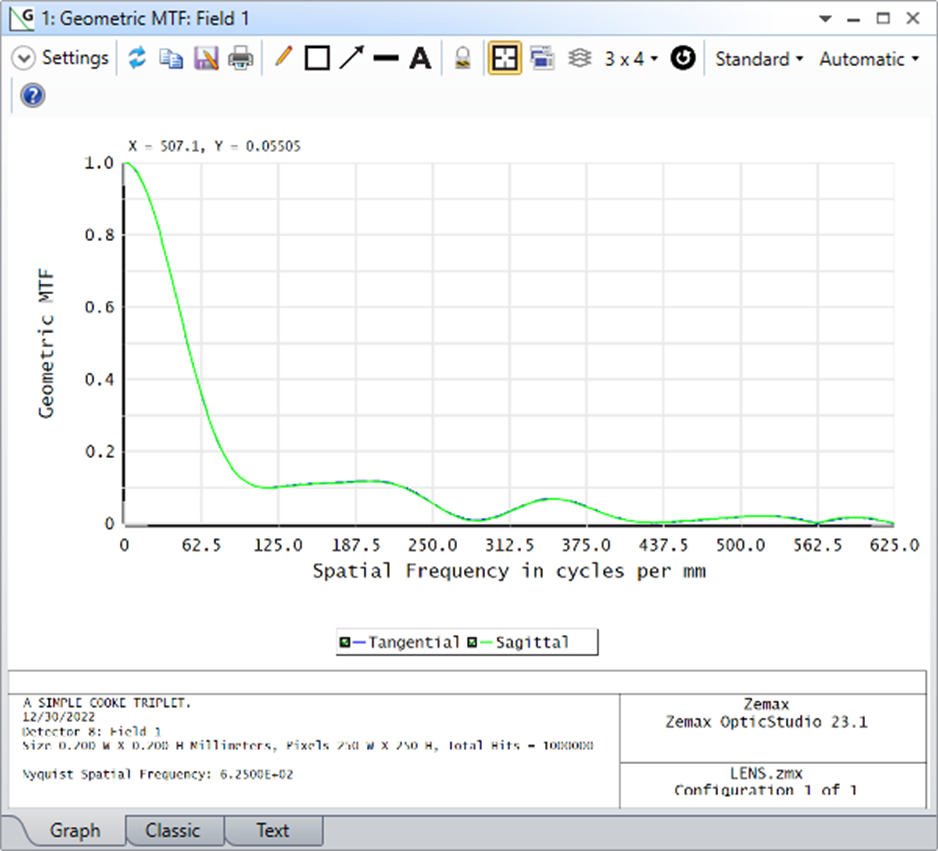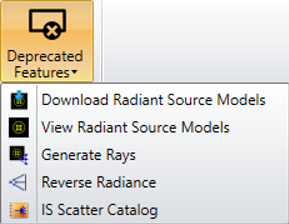
January 12th, 2023
1 Tools, Features, and Capabilities
1.1 NSC Surface Sag (Professional and Premium editions, Subscription only)
Easily analyze the shape of any complex surface in non-sequential mode to ensure manufacturability.
This new built-in analysis in OpticStudio uses non-sequential ray tracing to calculate the sag values of a specified face of an object defined in the Non-sequential Component Editor (NSCE).

The rays used for the sag calculation can be visualized in the Layout tab, which greatly assists with troubleshooting setup of the analysis.

The settings for this analysis include a “Keep Object Tilts” checkbox, which enables preservation of the object’s original x and y tilt. If this box is checked, the analysis will account for the tilts of the object when calculating the sag, and they’ll be ignored if this box is unchecked.
The analysis also lets the user remove the base radius, best-fit sphere, base sag, average sag, or minimum sag. The average and minimum sag allow for piston removal or to anchor the sag map to the lowest sag value.
1.2 NSC Geometric MTF (Professional and Premium editions, Subscription only)
Calculate the Geometric MTF on a detector in non-sequential mode.
This new feature allows users to calculate the Geometric MTF from the irradiance distribution on a detector in non-sequential mode. This feature replaces the Geometric MTF option in the Detector Viewer.

The Geometric MTF is calculated using all rays coming from all sources that land on the detector, not just rays originating from a single source in the system. Therefore, the results may differ between sequential and non-sequential calculations of the Geometric MTF. The results may also differ if the non-sequential system includes mechanical components with which rays may interact or if the system is set for rays to be split or scattered.
Importantly, the Geometric MTF in non-sequential mode is calculated in cycles/millimeters, regardless of the chosen MTF Units in the System Explorer.
1.3 Export to PanDao (Professional and Premium editions)
Determine the optimal fabrication chain at any point during the optical design process.
PanDao (https://pandao.ch/) has developed a browser-based tool for assessing the impact of lens fabrication methods on performance and cost. These assessments are created using relevant data from the optical design. Engineers are currently required to extract the relevant data from their optical models and input these into the PanDao toolset manually.
The Export to PanDao tool is a ZOS-API standalone application that helps automate the process by extracting the relevant data from an OpticStudio lens file and writing this to a JSON file that can subsequently be read in by the PanDao toolset.
This tool currently supports on-axis systems that use Standard surfaces that are spherical (the conic constant must be zero), Even Asphere, Extended Asphere, and Extended Odd Asphere surface types. Both refractive and reflective surfaces are supported.
2 Libraries and Catalogs
2.1 Catalog Updates (All editions)
Get the latest material catalogs from CDGM, GBJ, SABIC, NHG, Schott, Optotune, VIAOPTIC, and Acktar.
Material Catalogs
-
The CDGM material catalog has been updated:
-
Added 3 new glasses: D-ZK21, D-ZLaF85LN, F4GTi.
-
Low softening series glass (D-) provides refractive index data of two annealing rates, in which the serial number suffix "-25" indicates that the refractive index data of the glass is 25℃ corresponding data, and glasses without suffix is 4℃/h corresponding data.
-
Expand the index range to 2325nm for 73 glasses below, and change their dispersion formula to Sellmeier 1:
H-QK1, H-K1, H-K2, H-K3, K4A, H-K7, H-K8, H-K11, H-K50, H-K51, H-ZPK1A, H-ZPK3, H-BaK1, H-BaK2, H-BaK3, H-BaK4, H-BaK5, H-BaK8, H-ZK1, H-ZK2, H-ZK3A, H-ZK5, H-ZK7A, H-ZK8, H-ZK10, H-ZK14, H-ZK21, H-LaK1, H-LaK3, H-LaK4L, H-LaK6A, H-LaK8A, H-LaK11, H-LaK12, H-LaK50A, H-LaK53A, H-LaK59A, H-KF6, H-QF1, H-QF6A, H-QF8, H-QF50, H-QF50A, H-QF56, H-F2, H-F4, H-F13, H-BaF2, H-BaF3, H-BaF5, H-BaF6, H-ZBaF1, H-ZBaF3, H-ZBaF20, H-ZBaF50, H-ZF1, H-ZF5, H-ZF50, H-LaF1, H-LaF2, H-LaF3B, H-LaF4, H-LaF4GT, H-LaFL5, H-LaF7, H-LaF51, H-LaF62, H-ZLaF1, H-ZLaF50D, H-ZLaF51, H-ZLaF55C, H-ZLaF71AGT, H-ZLaF89L. -
The refractive index temperature range of 41 glasses was expanded from (-40~80) ℃ to (-60~140) ℃, and the refractive index temperature coefficient constant was revised:
H-K2, H-K8, H-ZPK1A, H-ZPK3, H-BaK6, H-ZK9B, H-ZK11, H-ZK14, H-ZK20, H-ZK50, H-ZK50GT, H-LaK5A, H-LaK12, H-LaK52, H-LaK53A, H-LaK59A, H-QF3, H-F1, H-F4, H-F13, H-F51, H-BaF4, H-ZBaF16, H-ZF3, H-ZF6, H-ZF7LA, H-ZF7LAGT, H-LaF3B, H-LaF6LA, H-LaF10LA, H-LaF50B, H-LaF52, H-LaF53, H-ZLaF75A, D-FK61, D-ZPK1A, D-ZK2L, D-ZF10, D-ZLaF52LA, D-ZLaF67, D-ZLaF85L.
-
-
The BIREFRINGENT material catalog has been updated:
-
Corrected the fit formula and parameters for Quartz and Quartz-E to match the definition in the original referenced paper T. Radhakrishnan, ‘‘Further Studies on the Temperature Variation of the Refractive Index of Crystals,’’ Proc. Indian Acad. Sci. A33: 22 – 34 (1951)
in Handbook of Optics, Vol. II.
-
-
The GBJ material catalog has been updated:
-
The refractive index test wavelength has been extended from the original 1014nm to 1692nm, and the corresponding dispersion formula constants are updated correspondingly. The extended materials include: H-QK3L, H-ZK10L, H-ZF13, H-LaK51, H-K9L, H-ZK21, H-ZF50, H-ZF5, H-ZK3, ZF1, H-ZF6, H-ZLaF52, H-ZK9A, ZF2-2, H-ZBaF50, H-ZLaF71, H-ZK11, ZF7L, H-F2, H-ZLaF76, H-LaK7A, H-LaF2, H-F13, H-ZF88, H-ZBaF21, H-LaK59, H-LaF3, H-ZLaF50E, H-ZF2, H-ZBaF1, H-LaF10, H-ZPK2, H-LaF50, H-ZBaF20, H-LaK8A, H-ZPK1, H-ZF1, H-ZF3, H-ZF7L, H-ZLaF4L, H-ZK6, H-ZF4, H-ZLaF55, H-LaK53, H-ZK7, H-ZF12, and H-ZLaF90.
-
The temperature range of refractive index coefficient has been expanded from -40℃-80℃ to -60℃-120℃, and the corresponding refractive index temperature coefficient constant is updated correspondingly. The updated materials include: H-QK3L, H-ZK10L, H-ZF13, H-LaK51, H-K9L, H-ZK21, H-ZF50, H-ZF5, H-ZK3, ZF1, H-ZF6, H-ZLaF52, H-ZK9A , ZF2-2, H-ZBaF50, H-ZLaF71, H-ZK11, ZF7L, H-F2, H-ZLaF76, H-LaK7A, H-LaF2, H-F13, H-ZF88, H-ZBaF21, H-LaK59, H-LaF3, H-ZLaF50E, H-ZF2, H-ZBaF1, H-LaF10, H-ZPK2, H-LaF50, H-ZBaF20, H-LaK8A, H-ZPK1, H-ZF1, H-ZF3, H-ZF7L, H-ZLaF4L, H-ZK6, H-ZF4, H-ZLaF55, H-LaK53, H-ZK7, H-ZF12, and H-ZLaF90.
-
Eight new high-permeability materials were added, mainly to update their internal transmittance: H-LaK2C, H-ZF4GT, H-ZF7LGT, H-ZFGT, H-ZF13GT, H-ZF52AGT, H-ZF62GT, H-ZF72GT, and H-ZF88GT.
-
Melting frequency and price coefficient have been updated for all materials.
-
-
The BIREFRINGENT material catalog has been updated:
-
Corrected the fit formula and parameters for Quartz and Quartz-E to match the definition in the original referenced paper T. Radhakrishnan, ‘‘Further Studies on the Temperature Variation of the Refractive Index of Crystals,’’ Proc. Indian Acad. Sci. A33: 22 – 34 (1951)
in Handbook of Optics, Vol. II.
-
-
The SABIC material catalog has been updated:
-
Added a new resin (EXTEM RH1016UCL) to the SABIC thermos-optical polymers catalogue. EXTEM™ RH1016UCL resin is a near-IR transparent thermoplastic with a glass transition temperature of 280°C. This injection moldable resin can produce complex optical lens assemblies while maintaining dimensional stability during 260°C peak temperature solder reflow assembly.
-
Changed the minimum wavelength to 300 nm for LEXAN_CXT17 and LEXAN_CXT19.
-
-
The NHG material catalog has been updated:
-
Added new materials H-FK76, H-LaK9, H-LaF50B, H-LaF56, H-ZLaF68L, H-ZLaF86, D-ZK3L-M90 and D-ZF93.
-
Updated temperature coefficients of refractive index of D-K9, refractive index of each band, dispersion, temperature coefficients of refractive index and phosphate resistance RP of H-LaK77, density of H-ZK21.
-
Updated thermal expansion coefficient α-50/80℃ of H-PK63, H-PK65, H-ZK21, H-LaK77, D-ZK3L and D-ZF10, thermal expansion coefficient α100/300℃ of H-PK63, H-LaK77 and D-ZF10.
-
Updated internal transmittance of H-ZK21, H-LaK50A, H-ZF72GT, H-ZF75GT, H-ZBaF50, H-LaF2, H-ZLaF54, H-ZLaF82 and D-ZLaF52N-M170.
-
Updated relative price and melting frequency of most materials.
-
-
The Schott material catalog has been updated:
-
Added new materials N-SF6Q2, SF3, N-LAK28, BK7G18, F2G12, SF6G05, LAK9G15, K5G20, LF5G19, N-LASF55, F2HTi, and N-SK5HTi.
-
Added CTE(20,300) for SF6G05.
-
Added dn/dT data for F2G12 and LAK9G15.
-
Corrected Abbe number for SF6G05.
-
-
The Optotune material catalog has been updated:
-
New catalog with 4 optical liquids: OL1024, OL1126, OL1129, OL1224.
-
Lens Catalogs
-
The OPTOTUNE lens catalog with 5 different models of focus-tunable liquid lenses has been added:
-
All focus-tunable liquid lenses emulate the human eye by producing focus changes by adjusting the curvature of a variable surface instead of axially shifting a rigid lens.
-
For each lens type, three different models are provided to represent three specific focus states of the lens: MAX represents the maximum focal power state (shortest positive focal length), MIN represents the minimum focal power state (shortest negative focal length), and MID represents the zero focal power state (infinite focal length).
- Available lens types:
-
EL-12-30-16D: Compact and fast electrically tunable lens. Focal power range is -6 to +10 dpt. Clear aperture is 12mm. Settling time is 10ms. Typical applications are C-mount lenses, machine vision, ophthalmology
- EL-16-40-5D: Large aperture, fast electrically tunable lens. Focal power range is -2 to +3 dpt. Clear aperture is 16mm. Settling time is 20ms. Typical applications are C-mount lenses, machine vision, microscopes
- EL-16-40-20D: Large aperture, high focal power range, electrically tunable lens. Focal power range is -10 to +10 dpt. Clear aperture is 16mm. Settling time is 40ms. Typical applications are zoom lenses, ophthalmology
- EL-3-10-26D: Small aperture, high focal power range, ultra-fast, electrically tunable lens. Focal power range is -13 to +13 dpt. Clear aperture is 3mm. Settling time is 4ms. Typical applications are S-mount lenses, code readers, lasers, oral scanners
- ML-20-37-36D: Large aperture, high focal power, manually tunable lens. Focal power range is -18 to +18 dpt. Clear aperture is 20mm. The lens can be actuated manually by rotating the outer diameter. Yet, it can also be automated by a gear drive. Typical applications are on benchtop optical systems and in ophthalmology to correct short and far sightedness
-
-
-
The VIAOPTIC material catalog has been updated:
-
New catalog containing 8 stock lenses.
-
Viaoptic is your specialist for plastic optical components. Vialens standard lenses from Viaoptic for collimation of narrowband light sources are ideally suitable for lasers of specific wavelengths available with different focal lengths.
- This catalog replaces the previous Philips Stock Lens Catalog, as that catalog has become obsolete since their acquisition of the laser collimation lens business of Helvoet/Philips.
-
Scatter Catalogs
-
Acktar:
-
16 new BSDF Scatter profiles have been added: Vacuum Black IR & VIS, Magic Black IR & VIS, Fractal Black IR & VIS, Lambertian Black IR & VIS, MaxiBlack IR & VIS, Metal Velvet IR & VIS, Spectral Black IR & VIS, Hexa Black IR & VIS
-
2.2 Deprecated RSMX and ISX Libraries (Professional and Premium editions)
These features are deprecated and will be removed in July 2023.
As of the 23.1 release the RSMX and ISX libraries are deprecated, and they will be removed from OpticStudio in July 2023. The reason for depreciation is that these libraries rely on obsolete Microsoft components that could potentially introduce IT or security vulnerabilities in the future. To replace the ISX libraries, new BSDF scatter libraries will be made available in Ansys Zemax OpticStudio in a future release, based on a format that can be easily updated and maintained in a secure manner (see section 5 for an important announcement).
A small set of features in OpticStudio rely on the presence of the RSMX and ISX libraries in the software, and these features are also now deprecated (and will subsequently be removed in the 23.2 release). Some of these features have been moved under the Zemax Lab Group > Deprecated Features button in the Help tab of the OpticStudio UI, as shown below:

In addition to the features shown in the image above, the REVR Merit Function Operand and the ReverseRadiance Detector and Target Objects are also deprecated.
3 Bug Fixes
-
TIRR & TEZI tolerancing operands – Fixed an issue in Zemax OpticStudio 22.3 where for perpetual licenses the Tolerance Wizard fails to populate the Tolerance Data Editor (TDE) with TIRR and TEZI operands.
-
Prepare for OpticsBuilder – Fixed an issue where Prepare for OpticsBuilder shows an error when converting a SEQ file, while the manual process of using the Convert to NSC Group tool and then Prepare for OpticsBuilder does work.
-
Text tab in analysis windows – Fixed an issue when a crash could occur by double clicking to update the text tab of an analysis window.
-
Solves – Fixed an issue where some solve parameters could be cut off due to incorrect solve window sizing.
-
Undo/Redo – Fixed an issue when the Project Directory is enabled for a lens system and an undo or redo operation can fail to locate external data files (e.g., CAD parts).
4 Announcement
Zemax OpticStudio 23.1 is the last major release of our legacy product (under legacy licensing) that will include new functionality as well as bug fixes. After this release, only bug fixes will be released in service pack releases for Zemax OpticStudio legacy until the end of 2023.
In order to continue to have access to the latest features, please contact sales@zemax.com to discuss migrating your legacy license to the Ansys Zemax OpticStudio.

